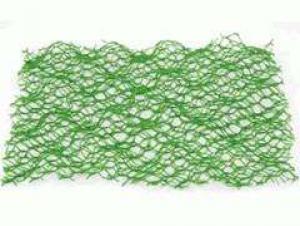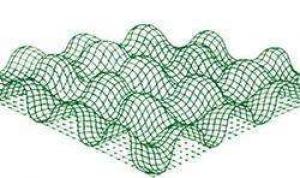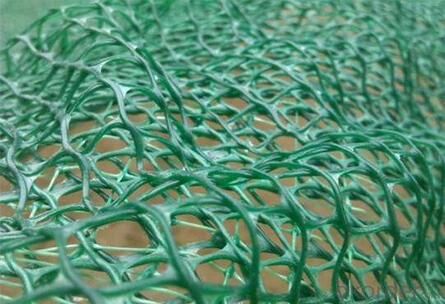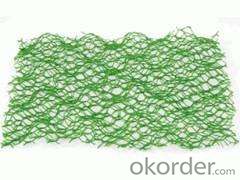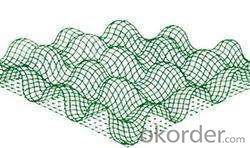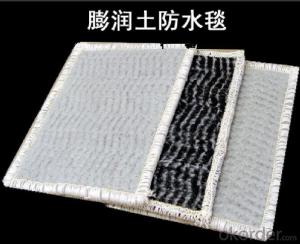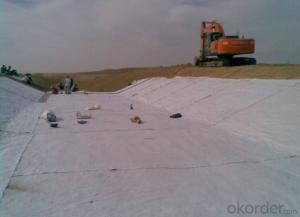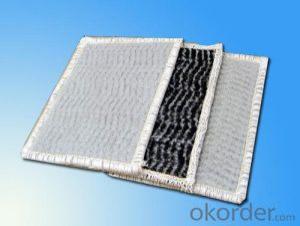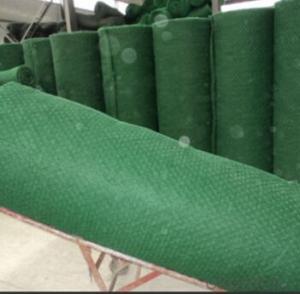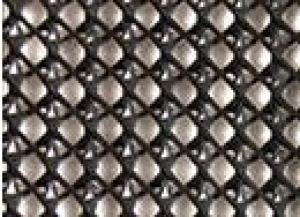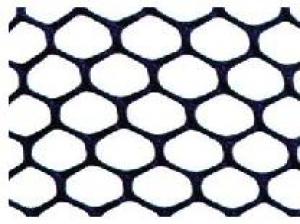3D Geomat for Highway and Railway Embankments
- Loading Port:
- Qingdao
- Payment Terms:
- TT or LC
- Min Order Qty:
- 1000 m²
- Supply Capability:
- 500000 m²/month
OKorder Service Pledge
OKorder Financial Service
You Might Also Like
Description:
CMAX Geomat is a new kind seed planting material with tridimensional structure, which can effectively prevent the soil being washed away, and increase the area of virescence, and improve our environment very well.
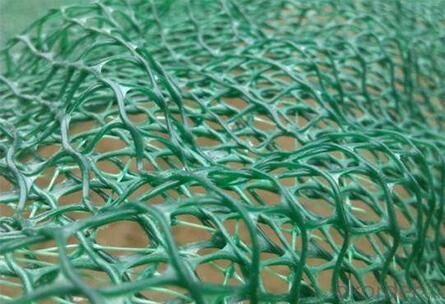
Specification:
Item: EM2, EM3, EM4, EM5
Thickness: 10mm-16mm
Width:2m or as request
Length:50m or as request
Color: green or black color
Property:
1) Before the greensward grows, it prevents the surface of the land from the erosion of the wind and rain.
2) Form compound protection layer with the vegetable, standing the wash-out of the high water level and large speed current.
3) Replace the concrete, asphalt, and block, using in the slope surface protection of roadway, railway, river-way, dyke, and the hillside, etc.
Application:
1) Prevent the surface of ground form weather beaten before the seeds growing up.
2) The compound protection layer will be forming after the grass grow up, which can endure wash by high level and high speed water.
3) It can be a substitute of the concrete, bitumen, stone, and so on to the perfect slop protection material. So it can be widely used in highway, railway, riverway, embankment and so on.
- Q: What are the different types of geosynthetic drainage systems?
- There are several types of geosynthetic drainage systems, including geocomposite drains, geonet drains, geospacer drains, and geotextile drains. Each of these systems utilizes different materials and designs to effectively drain water from various applications such as landfills, roadways, and retaining walls.
- Q: How are geosynthetic clay liners used in earthwork?
- Geosynthetic clay liners are used in earthwork as a barrier to prevent the migration of liquids or gases within soil or rock structures. These liners are typically installed in landfills, dams, and other construction projects to enhance the containment and stability of the earthwork. They offer excellent hydraulic conductivity and chemical resistance, providing an effective solution for environmental protection and geotechnical engineering.
- Q: Are earthwork products available in various colors and finishes?
- Yes, earthwork products are available in various colors and finishes.
- Q: What are the main features of gypsum for civil engineering materials?
- Has a certain humidity, fire resistance, water resistance, poor frost resistance
- Q: Are earthwork products resistant to impact and abrasion?
- Yes, earthwork products such as geomembranes and geotextiles are designed to be resistant to impact and abrasion. They are made from durable materials that can withstand physical stresses and provide long-lasting protection to the underlying soil or structures.
- Q: What are the specific applications of geosynthetics in earthwork projects?
- Geosynthetics have various applications in earthwork projects, including erosion control, soil reinforcement, drainage systems, and waste containment. They are commonly used as geotextiles to prevent soil erosion and stabilize slopes, as geogrids to reinforce soil and improve load-bearing capacity, and as geocomposites for drainage and filtration purposes. Additionally, geosynthetics are utilized in the construction of landfills, reservoirs, and dams to provide effective containment of waste materials and water. Overall, geosynthetics play a crucial role in enhancing the performance, durability, and sustainability of earthwork projects.
- Q: How do earthwork products contribute to erosion control on riverbanks?
- Earthwork products, such as geotextiles and erosion control blankets, play a vital role in controlling erosion on riverbanks. These products are specifically designed to stabilize the soil and prevent it from washing away during heavy rain or water flow. Geotextiles, for instance, act as a barrier between the soil and water, allowing water to pass through while keeping the soil in place. Erosion control blankets, on the other hand, provide immediate protection by covering the soil and preventing erosion caused by wind and water. By effectively controlling erosion, earthwork products help maintain the integrity of riverbanks, prevent sediment runoff into water bodies, and preserve the natural habitat of aquatic organisms.
- Q: For the civil engineering students, material mechanics need to grasp to what extent? Focus on Pretty good reference book
- Are you civil Material mechanics is the branch of the three major mechanics, of course, important, the design of the basis of the need to clearly grasp the material mechanics, such as the size of the beam design and check these in the engineering practice are directly used, many famous university entrance examination course is material Force rather than knot force can see its importance
- Q: What are the advantages of using geotextile mats in erosion control blankets?
- Geotextile mats offer several advantages in erosion control blankets. Firstly, they provide excellent stability and reinforcement to the soil, preventing erosion and soil movement. Secondly, they allow water to pass through while retaining soil particles, facilitating proper drainage and preventing waterlogging. Additionally, geotextile mats enhance vegetation growth by retaining moisture and providing a conducive environment for plant roots to establish. Lastly, these mats are durable, cost-effective, and easy to install, making them a practical choice for erosion control projects.
- Q: What are the different types of geosynthetic reinforcements for soil slopes?
- There are several types of geosynthetic reinforcements that can be used for soil slopes, including geogrids, geotextiles, and geocells. Geogrids are made from high-strength materials and provide tensile reinforcement to improve slope stability. Geotextiles are permeable fabrics that can be used for erosion control and filtration. Geocells are three-dimensional honeycomb-like structures that can be filled with soil to create a stable slope. These different types of geosynthetics offer various benefits and can be selected based on the specific requirements of the slope project.
Send your message to us
3D Geomat for Highway and Railway Embankments
- Loading Port:
- Qingdao
- Payment Terms:
- TT or LC
- Min Order Qty:
- 1000 m²
- Supply Capability:
- 500000 m²/month
OKorder Service Pledge
OKorder Financial Service
Similar products
Hot products
Hot Searches

